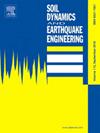Interface boundary technique of hybrid test for seismic ground response analysis
IF 4.2
2区 工程技术
Q1 ENGINEERING, GEOLOGICAL
引用次数: 0
Abstract
Seismic ground response analysis is critical in predicting ground surface motions and estimating earthquake-induced forces that triggers geologic hazards, such as liquefaction and landslide. Due to the lack of a rational and general interactive framework, hybrid tests for seismic ground response analysis have very limited progress. In this study, an interactive framework for general geotechnical models with an interface boundary technique is proposed to facilitate such hybrid tests. According to the geometry feature of the interface between physical and numerical subdomains in a ground model, the experimental control nodes are determined and the corresponding interface initial stiffness matrix is estimated using the displacement-based method and incorporated in the numerical model of the physical subdomain. Subsequently, the hybrid testing framework is built in the FEM program OpenSees and the associated middleware OpenFresco. To validate the proposed interface boundary method, hybrid test rehearsals, i.e. virtual hybrid tests were performed on a typical ground model with medium sand and stiff clay subjected to different earthquake motions. Compared with the numerical simulation, the results obtained from the hybrid test rehearsals show that the vertical stress and deformation of the ground were adequately captured by the interface boundary technique. To further illustrate the reliability of the interface boundary technique, the effects induced by the deviation of initial stiffness matrix estimation and the height of the physical subdomain are discussed with recommendations of future implementation of the hybrid tests for seismic ground response analysis.
求助全文
约1分钟内获得全文
求助全文
来源期刊

Soil Dynamics and Earthquake Engineering
工程技术-地球科学综合
CiteScore
7.50
自引率
15.00%
发文量
446
审稿时长
8 months
期刊介绍:
The journal aims to encourage and enhance the role of mechanics and other disciplines as they relate to earthquake engineering by providing opportunities for the publication of the work of applied mathematicians, engineers and other applied scientists involved in solving problems closely related to the field of earthquake engineering and geotechnical earthquake engineering.
Emphasis is placed on new concepts and techniques, but case histories will also be published if they enhance the presentation and understanding of new technical concepts.
 求助内容:
求助内容: 应助结果提醒方式:
应助结果提醒方式:


